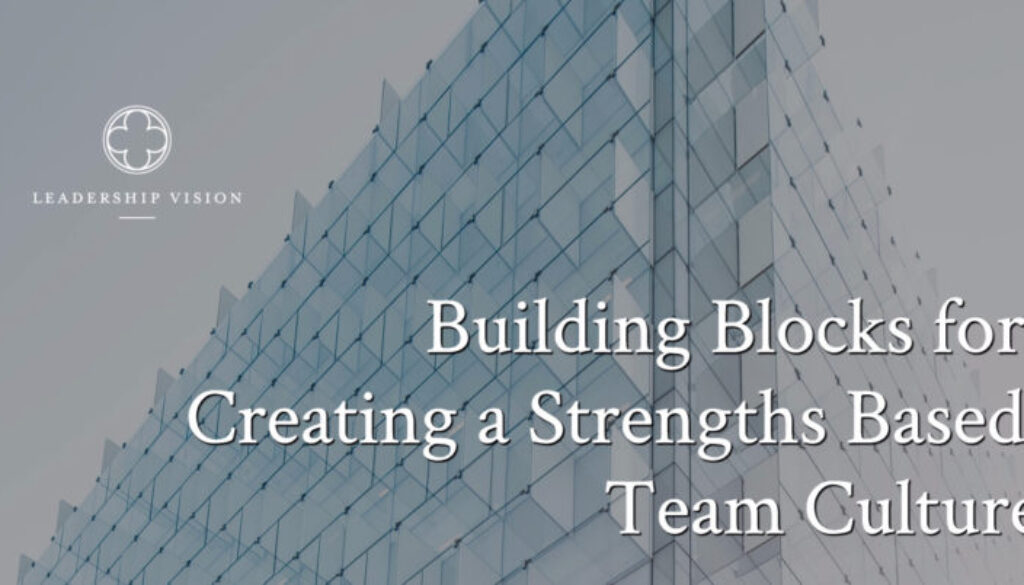Building Blocks for Creating a Strengths Based Team Culture
The high school volleyball team that I coach wrapped up its season in November. At the beginning of the season, I wrote a blog post pondering the benefits of StrengthsFinder™ for ‘younger’ people. I believe if young adults can gain a basic understanding of their Strengths, they will be able to develop self awareness and appreciate other people’s differences. This is a skill that is often learned later in life, but by taking StrenthsFinder™ and applying it at a young age, they are able to begin the journey to Strengths proficiency earlier rather than later.
Mid-way through our season I had a brief check-in with each girl particularly related to the Strengths work we did in August. I specifically wondered if they noticed their Strengths in other areas of their life, and how they would describe our team culture based on the Strengths of the team. Some of the girls had incredibly insightful feedback about how they have noticed their Strengths outside of volleyball.
By the end of our meetings, I was encouraged that these young women were beginning to think into their Strengths more and more each day. By cultivating their understanding of Strengths, we had given them a tool to continue learning.
The girls’ perspectives on how the Strengths of the team work together proved they still had much to learn about:
- How their own Strengths pair together
- The Strengths of teammates
- How individuals with different Strengths work together.
As coaches, my colleagues and I knew we were simply laying the foundation of a Strengths Based Culture.
Building Blocks
At the end of the season, the head coach and I had an individual meeting with each Varsity player. One question we asked was, “what feedback do you have for us, positive or negative on the season?” I expected to hear feedback on our number of wins and losses, how practices were organized, the amount of conditioning we did, or some other volleyball-related comment.
Instead, time and time again we heard, “I loved ‘that stuff’ we did at the beginning of the season with Strengths.” I had to hide my laughter at how they described the two-hour Strengths session, and bite my tongue at correcting their language. This is the building block phase, I reminded myself.
What We Learned
As I reflect back on the Strengths work we did with the team this season, there were a lot of great takeaways. There were also a few things I would have done differently. Here are the 5 most important things I gleaned from the experience:
- Learning never stops. Understanding your Strengths is a life-long learning process and there is always more knowledge to be gained regarding your Strengths. They work differently in each group or team, and understanding those nuances is critical to further Strengths development.
- Individuals, then team. To understand how a team’s Strengths work together, one must first have a foundational understanding of how their own Strengths work together. Second, a general knowledge of the Strengths of each individual teammate is necessary before the real work can begin.
- It all takes time. Cultivating a Strengths Based Culture is a process that requires laying a foundation, and then slowly building upon it. One sad thing about working with a team in a constant state of turnover (such as a high school sports team), is that we may not have the opportunity to see a real Strengths Based Culture emerge. At the very least, we’ve given the volleyball team, as individuals, a better understanding of themselves and a glimpse into what a team functioning within its Strengths can look like.
- It takes buy-in. In order for the foundation and building blocks of a Strengths Based Culture to last and make a difference: (a) the leaders of the group need to be on board and (b) there needs to be continual dialogue around Strengths. Looking back, I wish I would have first introduced the coaches to Strengths, then the players. This would have provided a similar level of knowledge to the coaches and helped to intentionally cultivate this new culture within the team.
- Constant Conversation. If you don’t continually have conversations about Strengths, the impact will be minimal. Three conversations about Strengths in a 2.5 month season isn’t enough to keep Strengths on the forefront of people’s minds. Next time, I would want to be more intentional about continuing the conversation about Strengths to keep the language and concepts fresh.
Reflect on This
How do your Strengths work differently in your groups or teams? What can you still learn about the Strengths of your teammates? How are you laying a foundation to create a Strengths Based Culture in your various spheres of influence?





